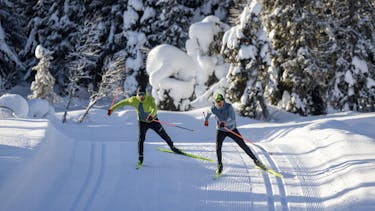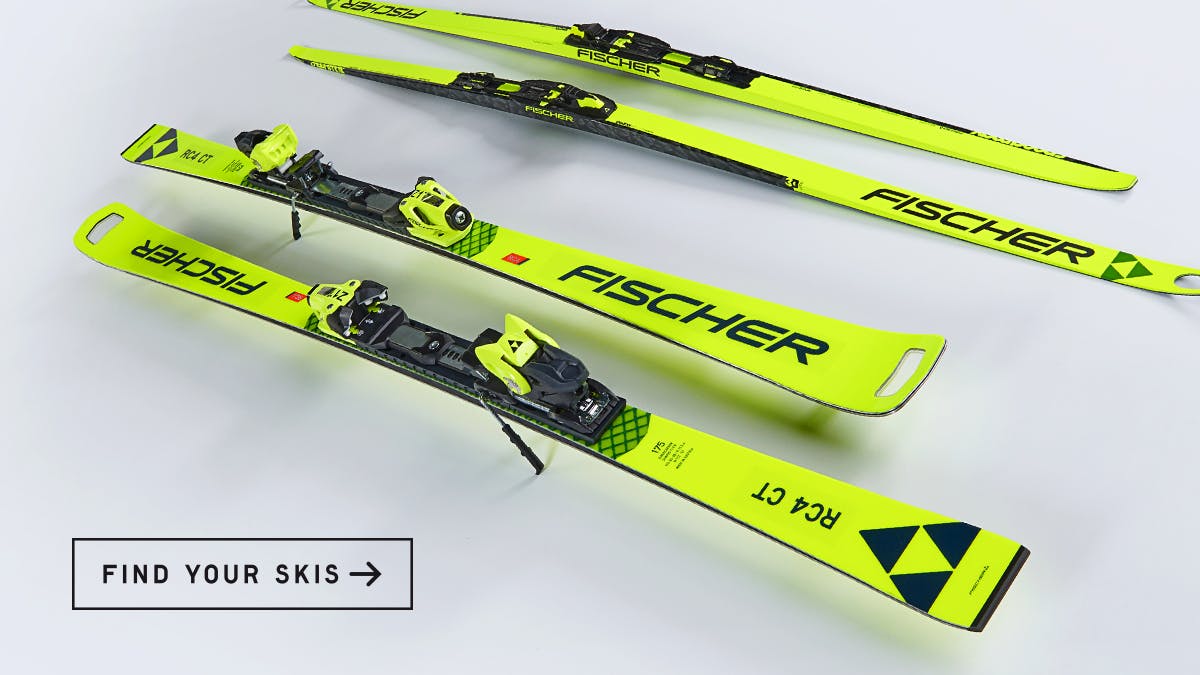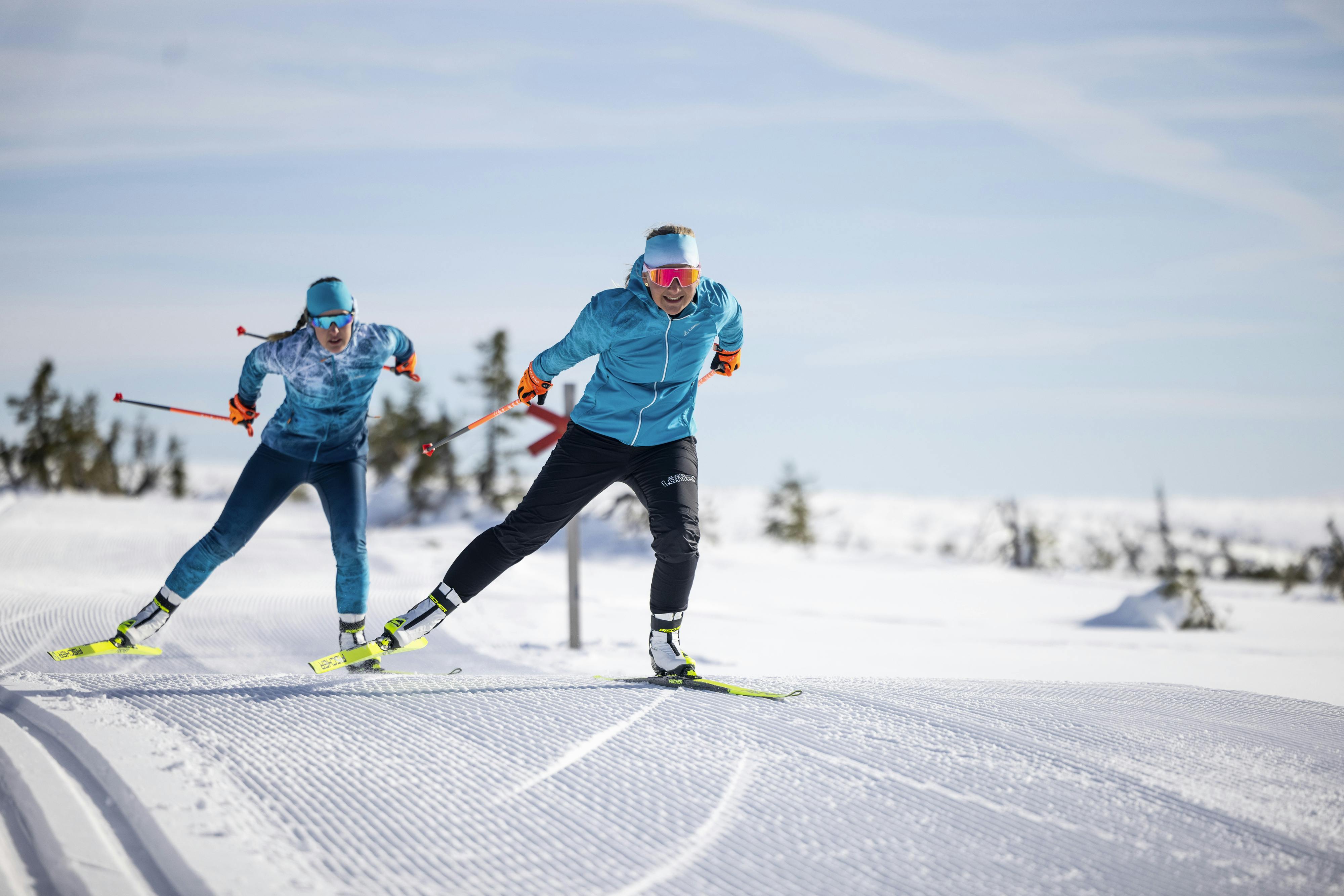Calculating length for classic cross-country skis vs. skating skis
The correct ski length means that the cross-country ski is neither too short nor too long. Great advice, don't you think? That's right, there's definitely more to it! First of all, the distinction between classic cross-country skis and skating skis: basically, the first one is longer.
What is the best length for classic cross-country skis?
In classic cross-country skiing, you ski on the loipe in flowing movements; your arms and legs swing diagonally to each other. The body weight is shifted evenly, alternating from one leg to the other. Basically, the classic style is very similar to normal walking and therefore perfect for cross-country beginners.
A special feature of classic cross-country skis is the climbing zone. To move forward, you need good grip, especially when ascending. Therefore, the climbing zone needs to interlock with the snow so you can walk uphill. Your body weight is crucial for pressing the skis into the snow. A simple formula for length calculation would be: Body size (cm) + 20-30 cm = ski length
Whether you use 20, 25, 30 cm or something in between in this formula depends on your level of experience. If you are just starting out with cross-country skiing, the ski may well be chosen a bit shorter. For advanced skiers, longer models are suitable.
If you prefer an exact length for your skis, have a look at our Product Finder. After entering your exact weight, we will calculate the best length for you depending on the model you’ve chosen. If several lengths are given, the longer length always applies to the more experienced skier while the shorter length is better for a less experienced skier.
What length is best for skating skis?
Cross-country skating is perfect for people approaching cross-country skiing with an extra portion of sporting ambition. Similar to inline skating, the running style is sporty and dynamic. A certain level of fitness is definitely advised when skating, since it is more exhausting than classic cross-country skiing. By the way, one usually skates in a particular skating track.
The skating ski itself has no climbing zone and is much stiffer than a classic cross-country ski. As far as the length is concerned, you can take the following formula as a rule of thumb:
Bodz size (cm) + 10-15 cm = ski length
Instead of adding 10 cm absolute skating beginners can also get started using skis only 8 cm longer than their body size. When entering your personal info into our Product Finder, you can also find additional help for skating. This will help you find out which length you need for a model!
Best cross-country ski length for kids
Cross-country skiing for kids is healthy and fun: the perfect deal! From the age of 3-5 years it makes sense taking the kids with you on the trail and letting them make their first experiences in classic cross-country skiing. Not focusing on the kids sporting ambition to avoid the kid feeling overwhelmed is very important.
The following rule of thumb can be used for kids:
- Skating: For beginners take the body size and subtract 5 to 10 cm. For advanced kids take the body size and add 5 cm to 10 cm
- Classic: For beginners take the body size and add +10 cm, for advanced kids take the body size and add 10 cm - 20 cm
Cross-country skis for kids are available in lengths between 110 and 170 cm. In case of doubt, it is always better to choose a slightly shorter version - especially if the child still stands at the beginning of his cross-country skiing career and has to get used to it first.
When parents and child have found the right cross-country skis, they are ready for the snow - are they? Yes, as long as the rest of the equipment is suitable!

Cross-country ski size + cross-country poles = perfect match
Sure thing, for cross-country skiing one needs the skis - but just as important are the matching ski poles! They give you the needed momentum and should also be chosen in a length that suits your skiing style best.
What is the best ski pole length for cross-country skiing?
Just like with your cross-country skis, you should pay close attention to your poles. Whether you are classic cross-country skiing or skating, these following rules of thumb apply:
- Classic cross-country ski pole: body size (cm) x 0.85 = pole length
- Ski pole for skating skis: body height (cm) x 0.90 = pole length
Here is an example of a female skier with a height of 168 cm:
- Classic: 168 cm x 0.85 = 142.8 cm
- Skating: 168 cm x 0.90 = 151.2 cm
In any case, the bottom line is skating ski poles being about 10 cm longer than the classic ones. A classic cross-country ski pole should end approximately at shoulder height, or at armpit height if it is stuck in the snow. The skating pole reaches approximately up to the chin/mouth, at maximum to the nose.
Since kids grow fairly fast, an adjustable cross-country ski pole (Vario Pole) is recommended. This kind of ski pole can be modified in just a few steps, it can be used by the kids for both skiing techniques and grows with them for at least 2-3 years.
The perfect cross-country skiing equipment
You have cross-country skis, poles and a matching couple of bindings and shoes? Then all that's missing are the details. The remaining equipment for cross-country skiing should include:
- windproof, breathable clothing that you can wear based on the onion principle (different layers of clothes)
- a head warmer (headband or sports cap)
- glasses protecting from UV radiation
- gloves with sufficient freedom of movement to keep a good grip on the ski poles
- depending on the length of the tour, a small backpack or a hip bag for snacks, drinks, keys, etc.
Good to go? Then you can finally start your day on the track or skating loipe - have fun!







